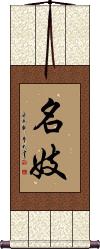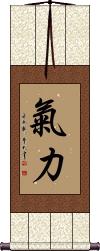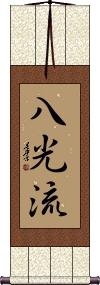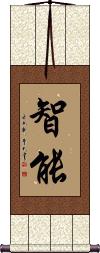Many custom options...
And formats...

Talent in Chinese / Japanese...
Buy a Talent calligraphy wall scroll here!
Personalize your custom “Talent” project by clicking the button next to your favorite “Talent” title below...
Geisha of Unequaled Talent
(Danger: Can mean prostitute!)
In Japanese, 名妓 means “distinguished/talented/beautiful geisha.”
The meaning in Chinese (and the deeper meaning in Japanese) would be “distinguished/talented/beautiful prostitute.”
I am not sure that our master calligrapher will even write this, so please note that fact if you decide to place the order. Of course, we'll refund your money if he refuses.
Strength / Vigor / Energy
Physical Strength
氣力 can mean any of the words in the title above, and in some contexts, can also mean effort, will-power, or talent.
This refers mostly to physical strength (as opposed to mental or spiritual).
![]() In modern Japan, they use a simplified first character for this word. If you want to order this title with that special Japanese version, click on the character to the right instead of the button above.
In modern Japan, they use a simplified first character for this word. If you want to order this title with that special Japanese version, click on the character to the right instead of the button above.
Crouching Tiger Hidden Dragon
臥虎藏龍 is the movie title of the Kung Fu epic that was very popular in the west a few years back.
This is a re-ordering of an ancient Chinese proverb that refers to undiscovered talents.
The movie was one of the most popular Chinese foreign films to ever debut in the USA but received a lukewarm reception in China.
Note: This can be pronounced in Korean, but it's not a commonly used term.
Hakko-Ryu
八光流 (Hakkō-Ryū) is a style of jujutsu associated with Daito-Ryu.
The title Hakko-Ryu comes from the Japanese phrase which translates as “The Style of the Eighth Light,” or more literally, “Eighth Light Style.”
The 光 character is associated with brightness or brilliance. It can be used to describe someone of great talent or potential. So the meaning goes far beyond just light.
Intelligence / Intellect
These two characters mean intelligence or intelligent.
The first character means wisdom, intellect, or knowledge.
The second means ability, talent, skill, capacity, capable, able, and can even mean competent.
Together, 知能 can mean “capacity for wisdom,” “useful knowledge,” or even “mental power.” Obviously, this translates more clearly into English as “intelligence.”
Note: This is not the same word used to mean “military intelligence.” See our other entry for that.
![]() In modern Japan, they tend to use a version of the first character without the bottom radical. If your audience for this artwork is Japanese, please click on the Kanji to the right instead of the button above.
In modern Japan, they tend to use a version of the first character without the bottom radical. If your audience for this artwork is Japanese, please click on the Kanji to the right instead of the button above.
Not the results for talent that you were looking for?
Below are some entries from our dictionary that may match your talent search...
| Characters If shown, 2nd row is Simp. Chinese |
Pronunciation Romanization |
Simple Dictionary Definition |
能 see styles |
néng neng2 neng nozaki のざき |
More info & calligraphy: Neng(1) talent; gift; function; (2) noh (theatre); (surname) Nozaki śak. Able to, can; capability, power. |
力量 see styles |
lì liang li4 liang5 li liang rikiryou / rikiryo りきりょう |
More info & calligraphy: Strength / Ability(1) ability; capacity; capability; talent; (2) physical strength |
氣力 气力 see styles |
qì lì qi4 li4 ch`i li chi li |
More info & calligraphy: Strength / Vigor / Energy |
蛟龍 蛟龙 see styles |
jiāo lóng jiao1 long2 chiao lung kouryuu / koryu こうりゅう |
More info & calligraphy: Water Dragon / Rain Dragon(1) mizuchi; mythical dragon-like beast, believed to ascend to the heavens through rain; (2) unfulfilled genius; dormant talent; (given name) Kōryū |
開花 开花 see styles |
kāi huā kai1 hua1 k`ai hua kai hua haruka はるか |
More info & calligraphy: Opening / Blooming Flowers(n,vs,vi) (1) flowering; blooming; blossoming; coming into bloom; (n,vs,vi) (2) flowering (of a civilization, talent, etc.); blossoming; blooming; bearing fruit (of efforts); (female given name) Haruka |
臥虎藏龍 卧虎藏龙 see styles |
wò hǔ cáng lóng wo4 hu3 cang2 long2 wo hu ts`ang lung wo hu tsang lung |
More info & calligraphy: Crouching Tiger Hidden Dragon |
藏龍臥虎 藏龙卧虎 see styles |
cáng lóng wò hǔ cang2 long2 wo4 hu3 ts`ang lung wo hu tsang lung wo hu |
More info & calligraphy: Hidden Dragon Crouching Tiger |
伎 see styles |
jì ji4 chi takumi たくみ |
artistry; talent; skill; (in ancient times) female entertainer (irregular kanji usage) technique; art; skill; (personal name) Takumi Skill; 伎巧; 伎藝. |
具 see styles |
jù ju4 chü tomo とも |
tool; device; utensil; equipment; instrument; talent; ability; to possess; to have; to provide; to furnish; to state; classifier for devices, coffins, dead bodies (1) tool; means; (2) ingredients (added to soup, rice, etc.); (counter) (3) counter for sets of armor, utensils, furniture, etc.; (female given name) Tomo All; complete; to present; implements; translit. gh. |
妒 see styles |
dù du4 tu to |
to envy (success, talent); jealous envy |
才 see styles |
cái cai2 ts`ai tsai mitsu みつ |
ability; talent; sb of a certain type; a capable individual; then and only then; just now; (before an expression of quantity) only (1) ability; gift; talent; aptitude; genius; (2) sai; traditional unit of volume, approx. 1.8 ml; (given name) Mitsu ability |
材 see styles |
cái cai2 ts`ai tsai motoki もとき |
material; timber; ability; aptitude; a capable individual; coffin (old) (n,n-suf) (1) wood; lumber; timber; (2) (raw) material; stuff; (3) talent; ability; capable person; (personal name) Motoki |
腕 see styles |
wàn wan4 wan ude うで |
wrist; (squid, starfish etc) arm (1) arm; (2) ability; skill; talent; competence; (3) (physical) strength; (place-name) Ude [upper] arm |
輇 辁 see styles |
quán quan2 ch`üan chüan |
limited (of talent or ability); (archaic) solid wheel (without spokes) |
スジ see styles |
suji スジ |
(1) muscle; tendon; sinew; (2) vein; artery; (3) fiber; fibre; string; (4) line; stripe; streak; (5) reason; logic; (6) plot; storyline; (7) lineage; descent; (8) school (e.g. of scholarship or arts); (9) aptitude; talent; (10) source (of information, etc.); circle; channel; (11) well-informed person (in a transaction); (12) logical move (in go, shogi, etc.); (13) (shogi) ninth vertical line; (14) seam on a helmet; (15) (abbreviation) gristly fish paste (made of muscle, tendons, skin, etc.); (16) (archaism) social position; status; (n-suf,n,adj-no) (17) on (a river, road, etc.); along; (suf,ctr) (18) counter for long thin things; counter for roads or blocks when giving directions; (19) (archaism) (Edo period) counter for hundreds of mon (obsolete unit of currency); (given name) Suji |
ヒト see styles |
hito ヒト |
(1) man; person; (2) human being; mankind; people; (3) (kana only) human (Homo sapiens); humans as a species; (4) character; personality; (5) man of talent; true man; (6) another person; other people; others; (7) adult |
一芸 see styles |
ichigei / ichige いちげい |
an art; one talent |
不才 see styles |
bù cái bu4 cai2 pu ts`ai pu tsai fusai ふさい |
untalented; I; me (humble) lack of talent; incompetency |
不敏 see styles |
bù mǐn bu4 min3 pu min fubin ふびん |
(noun or adjectival noun) (1) slowness; inertness; (noun or adjectival noun) (2) inability; lack of talent; dullness; stupidity not clever |
享有 see styles |
xiǎng yǒu xiang3 you3 hsiang yu kyouyuu / kyoyu きょうゆう |
to enjoy (rights, privileges etc) (noun, transitive verb) possession (of a right, talent, etc.); enjoyment |
人傑 人杰 see styles |
rén jié ren2 jie2 jen chieh jinketsu じんけつ |
outstanding talent; wise and able person; illustrious individual great person; outstanding talent; hero |
人才 see styles |
rén cái ren2 cai2 jen ts`ai jen tsai jinsai じんさい |
talent; talented person; looks; attractive looks (noun - becomes adjective with の) (See 人材・1) capable person; talented person; (given name) Jinsai |
伎倆 伎俩 see styles |
jì liǎng ji4 liang3 chi liang giryou / giryo ぎりょう |
trick; scheme; ploy; skill ability; competency; talent; skill; capacity |
伯樂 伯乐 see styles |
bó lè bo2 le4 po le |
Bole (a man who lived during Spring and Autumn Period, reputed to be able to spot a good horse); a person who is good at spotting talent |
俊傑 俊杰 see styles |
jun jié jun4 jie2 chün chieh toshitake としたけ |
elite; outstanding talent; genius hero; genius; (personal name) Toshitake |
俊才 see styles |
shunsai しゅんさい |
prodigy; talented person; person of exceptional talent; genius |
俊豪 see styles |
toshitake としたけ |
talent; man of outstanding learning and virtue; (given name) Toshitake |
偉器 伟器 see styles |
wěi qì wei3 qi4 wei ch`i wei chi takeki たけき |
great talent (personal name) Takeki |
偉才 see styles |
isai いさい |
genius; prodigy; (person of) great talent; remarkable person |
偉材 see styles |
izai いざい |
extraordinary talent; genius |
Click here for more talent results from our dictionary
The following table may be helpful for those studying Chinese or Japanese...
| Title | Characters | Romaji (Romanized Japanese) | Various forms of Romanized Chinese | |
| Geisha of Unequaled Talent | 名妓 | mei gi / meigi | míng jì / ming2 ji4 / ming ji / mingji | ming chi / mingchi |
| Strength Vigor Energy | 氣力 气力 / 気力 | kiryoku | qì lì / qi4 li4 / qi li / qili | ch`i li / chili / chi li |
| Crouching Tiger Hidden Dragon | 臥虎藏龍 卧虎藏龙 | wò hǔ cáng lóng wo4 hu3 cang2 long2 wo hu cang long wohucanglong | wo hu ts`ang lung wohutsanglung wo hu tsang lung |
|
| Hakko-Ryu | 八光流 | hakkou ryuu hakkouryuu hako ryu | ||
| Intelligence Intellect | 智能 / 知能 智能 | chinou / chino | zhì néng / zhi4 neng2 / zhi neng / zhineng | chih neng / chihneng |
| In some entries above you will see that characters have different versions above and below a line. In these cases, the characters above the line are Traditional Chinese, while the ones below are Simplified Chinese. | ||||
Successful Chinese Character and Japanese Kanji calligraphy searches within the last few hours...








